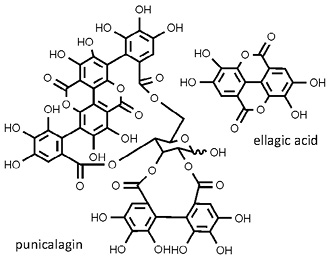 Punica granatum
Punica granatum
pomegranate • anardana
Back to “Spices: anardana (Punica granatum)s”
Punica granatum L. (Lythraceae); granaat (Afrikaans); roman (Arabic); shi liu, shi liu pi (Chinese); granaatappel (Dutch); grenade (French); Granatapfel (German); anar, anardana (Hindi); melogranate (Italian); delima (Indonesian); zakuro (Japanese); romã (Portuguese); granada (Spanish); tap tim (Thai); nar, rumman (Turkish)
DESCRIPTION The spice called anardana refers to the seeds of sour cultivars of pomegranate that are dried until they become dark purplish-brown and only slightly fleshy. Ripe seeds with their attractive bright red, fleshy, translucent arils and the red juice or concentrate produced from them have a delicious astringent, sweet and sour taste.
THE PLANT A thorny shrub or small tree. Each of the glossy leaves has a distinctive extrafloral nectar gland at the tip.
ORIGIN An ancient cultigen of Middle Eastern (Persian) origin and perhaps originally indigenous to parts of Turkey and the adjoining Caspian region.1 From here it spread to all parts of the Middle East, the Mediterranean region, India and the dry parts of Southeast Asia, and in the 17th century also to Central and North America.2 Pomegranate features prominently in ancient symbols and mythology.1
CULTIVATION Seeds are easy to germinate but cuttings are mostly used for commercial plantations.2 The pomegranate is an old favourite in kitchen gardens in temperate regions because it adapts well to extreme conditions. Cultivars differ mainly in the size and colour of the fruits and the hardness and sweetness of the seeds. Popular commercial cultivars are ‘Wonderful’ and ‘Grenada’.2
HARVESTING Fruits are hand-picked when fully ripe. The seeds are extracted and dried in the sun for about two weeks to make anardana.
CULINARY USES Anardana is an important spice in northwestern Indian cuisine. It is used to acidify curries and sweet-and-sour dishes (in much the same way as is done with tamarind and kokum). Pomegranate seeds (fresh or frozen) and juice are used in Mediterranean and Middle Eastern (e.g. Lebanese and Iranian) syrups, sauces, soups, meat dishes, stuffed fish, salads and sweet couscous.3 Pomegranate has become universally popular in recent years, not only as health drink but also for adding colour and flavour to many dishes. Pomegranate jelly can be made by adding pectin and sugar to the fresh juice.2 Grenadine is a popular bright red pomegranate-based concentrate used in mixed drinks, aperitifs and cocktails (e.g. tequila sunrise).
FLAVOUR COMPOUNDS The dried fruit aril contains fructose (25%), phytic acid (2.2%), punicalagins (0.57%) and tannins (e.g. ellagic acid and derivatives). The aroma of fresh pomegranate has been described as green, fruity, floral and earthy,3 and is associated with numerous aroma-active compounds which include hexanal, cis-3-hexenal, 1-octen-3-one and β-damascenone. In another study, the aroma-active compounds of the ‘Wonderful’ cultivar were identified and described as green (hexanal and cis-3-hexenal), floral (2-ethyl-hexanol) and fruity (ethyl-2-methylbutanoate, limonene, β-caryophyllene and 2(5H)-furanone). 4

NOTES The juice is exceptionally high in polyphenols with antioxidant activity.1
1. Mabberley, D.J. 2008. Mabberley’s plant-book (3rd ed.). Cambridge University Press, Cambridge.
2. Morton, J. 1987. Pomegranate. pp. 352–355. In: Fruits of warm climates. Julia F. Morton, Miami, Florida.
3. Cadwallader, K.R., Tamamoto, L.C., Sajuti, S.C. 2010. Aroma components of fresh and stored pomegranate (Punica granatum L.) juice. ACS Symposium Series, No. 136 (Flavors in noncarbonated beverages), American Chemical Society, Washington, pp. 93–101.
4. Mayuoni-Kirshinbaum, L., Tietel, Z., Porat, R., Ulrich, D. 2012. Identification of aroma-active compounds in ‘Wonderful’ pomegranate fruit using solvent-assisted flavour evaporation and headspace solid-phase micro-extraction methods. European Food Research and Technology 235: 277−283.